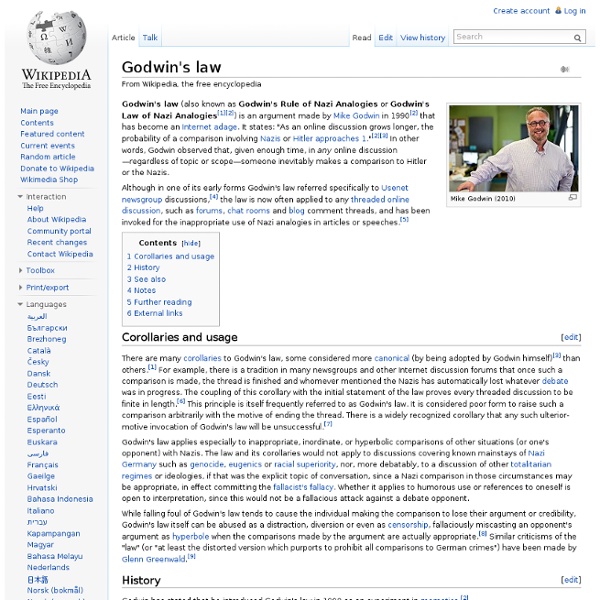Godwin's law

The electronic age facing memory loss?
These three articles have previously been published in the Swedish daily Svenska Dagbladet in 1994:Svensk version från Svenska Dagbladet 1994. I. The electronic age - on the verge of total memory loss?II. I. by Karl-Erik Tallmo Computers have memory. What will happen to all this, when so much is and will be published and stored solely on electronic media? Vice-president Al Gore envisions an information superhighway that will provide both schoolchildren and scientists with information and reference materials from all corners of the world. The computerization of public libraries started with the catalogues. The Center for Electronic Texts in the Humanities (CETH, at Rutgers University in New Brunswick, New Jersey) estimates that 8,000 series of source texts within the humanities already have been converted to machine-readable form world-wide. Thesaurus Linguae Graecae is text-only, but text in abundant quantity: 57 million words. Pictures are also accessible through computers and modems.
[Etude] Twitter vs Facebook vs Google Buzz : les chiffres remis
Je ne sais pas si vous avez remarqué, mais ces derniers jours, tous les sites High-Tech ou presque ont publié l’image (voir plus bas) du nombre de tweets envoyés par jours depuis les débuts du services. J’avoue que je n’en peux plus de la voir tout au long des mes flux RSS. Mais comme je suis un peu maso, je vais la publier encore une fois sur ce blog (oui, je suis un dingue) :
Poe's law
Confusion of parody and sincere expression Poe's law is an adage of Internet culture saying that, without a clear indicator of the author's intent, every parody of extreme views can be mistaken by some readers for a sincere expression of the views being parodied.[1][2][3] Origin[edit] Poe's law is based on a comment written by Nathan Poe in 2005 on christianforums.com, an Internet forum on Christianity. The reply by Nathan Poe read:[1] Without a winking smiley or other blatant display of humor, it is utterly impossible to parody a Creationist in such a way that someone won't mistake for the genuine article. The original statement of Poe's law referred specifically to creationism, but it has since been generalized to apply to any kind of fundamentalism or extremism.[3] Avoid sarcasm and facetious remarks. See also[edit] References[edit] External links[edit] How to Tell a Joke on the Internet, The Atlantic
Pinstamatic - Get More From Pinterest
Veille et intelligence économique pour les PME PMI TPE - Activei
Astronomy Answers: Coincidence Periods
Loading [MathJax]/jax/output/CommonHTML/fonts/TeX/fontdata.js 1. Introduction At least 2500 years ago astronomers in Babylon discovered that solareclipses and lunar eclipses often recur under similar circumstances after 223 synodical months (counted according to the phases of the Moon, not according to the western calendar) or about 6585⅓ days. This period is nowadays called the saros. To get a solar eclipse or lunar eclipse, two independents series of periodic phenomena must come together, namely the proper phase of the Moon (New Moon for a solar eclipse, or Full Moon for a lunar eclipse) and passage of the Moon through a node of the orbit of the Moon around the Earth. 2. We study the coming together of two different periodic phenomena A and B. PAPB=γ′=ab with a and b whole numbers. If an A and a B happen at the same time then we get the combination phenomenon Z. In our example, Z is a solar eclipse or lunar eclipse. We can associate each A with a prediction series. s≡ak+s0(modb) 3. c=PAδ
Geco Mark II – The World’s First Glasses Mounted Action Cam | Digital Street SA
What Is Geco? The Geco Mark II is the world’s smallest HD action cam that can be mounted to any pair of glasses for a first person point of view. Weighing in at just below 18 grams, it will be the smallest action camera in the world and with the price point that they are striving toward, the most affordable. It’s simple, hands-free and records in 720p! How Geco Will Change the Market Place? Putting the Geco into production will set the benchmark for micro action cams and will be a new form factor in the action cam industry, allowing for a unique viewing angle that captures the moment as if it was through the eyes of the person filming it. How It All Began They self-funded this project from the beginning, developing numerous prototypes, conducting tests and analyzing feedback for the past year. With each Geco Mark II you will receive: FAQs Q. Q. Q. Q. Q. Q. Q. Q. Geco. More Information @ Indiegogo
RadarVirtuel.com
16 Government Types - Infographic Facts
16 Government Types The Way Governments Works
Related:



